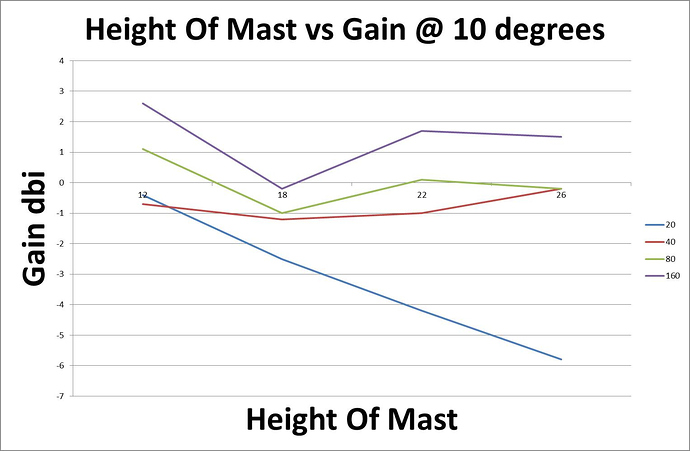I am in the process of brainstorming ideas for a vertical antenna to go on just under 3 acres of land. I primarily want to use this on 80m & 40m. 160m & 20m would be a nice bonus if it works, but are not critical.
The primary goal is DX, so looking for low angle radiation.
I am planning on building this around a Spiderbeam fibre glass mast, with 32 ground radials (which are each 20 meters long).
Spiderbeam sell this mast in four different lengths:- 12 meters (which I already own & is relatively cheap), 18 meters, 22 meters (starting to get expensive) and 26 meters (mega expensive and probably out of my price range).
My original plan was to use either a 18 meter or a 22 meter mast to build a full size 1/4 wave for the 80m band. Then I realised that I could potentially mount a remote tuner (such as a CG-3000 or MFJ-926b etc) at the base. The length then becomes less critical (as the tuner can deal with the mis-match).
I did however wonder how the length of the vertical element would affect the radiation pattern. I can imagine an 18 or 22 meter vertical working in both the 80m band & 40m band (approximately 1/4 wave vertical on 80m and approximately 1/2 wave on 40m), but I wondered what results this would give on 20m & 160m.
I decided to run several simulations on MMANA to see how the height of the vertical antenna affects the low angle gain, which (for a 10 degree take off angle) produced the graph below:-
This seems counter-intuitive to me and has left me a little confused!!!
The graph seems to suggest that the shorter 12 meter tall mast will give better results at a lower angle of radiation than the 18 or 22 meter masts.
I thought that the 12 meter mast would be a bit too short for 80m & 160m. I would have expected that the longer mast would have been better to get as near to a 1/4 wave as possible on 80m & get more wire up in the air. The table seems to suggest that my theory is completely wrong and that the shorter mast is in fact the best option as long as I can match it (which I’m sure that the tuner will)?
I did the same exercise for all of the following angles of radiation:- 5 degrees, 10 degrees, 15 degrees, 20 degrees. All produced the same results.
Am I missing something here? Is the software lying to me (the saying “put rubbish in = get rubbish out” springs to mind) or am I genuinely better off going with the shorter mast?
I’ve not looked at high angles of radiation for making NVIS contacts, but I’m planning on putting in a separate antenna for NVIS (a 75 meter long doublet), so I really don’t care about the high angles for this particular antenna.
Your thoughts?

 73 Éric
73 Éric